p.288
p.292
p.296
p.300
p.306
p.310
p.314
p.318
p.322
Investigation of Copper Foil Thinning Behavior by Flexible-Pad Laser Shock Forming
Abstract:
This paper reports on a novel microforming technique, Flexible-Pad Laser Shock Forming (FPLSF) which uses laser-induced shock waves and a flexible pad to induce plastic deformation on metallic foils. Thickness distribution at the cross-section of the craters formed by FPLSF is analyzed experimentally with respect to laser fluence, which is a significant process variable that controls the deformation pressure. Furthermore, hardness of the deformed samples at the cross-section is measured by nanoindentation testing. It is found that the thinning of copper foil by FPLSF ranges from 7% to 25% for laser fluence ranging between 7.3 J/cm2 and 20.9 J/cm2. Thinning is maximum at the crater center, which can be attributed to the maximum compressive stresses in the thickness direction, and minimum at the edge portions. With increase in laser fluence, thinning of the foil increases whereas minimum change in hardness is observed. The variation in thinning across different crater locations ranges between 6% and 8% only, which indicates that FDLSF can be developed as a competitive technique to produce components with uniform thickness distribution.
Info:
Periodical:
Pages:
306-309
Citation:
Online since:
January 2013
Price:
Сopyright:
© 2013 Trans Tech Publications Ltd. All Rights Reserved
Share:
Citation:


